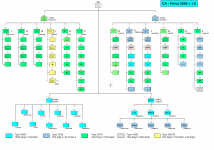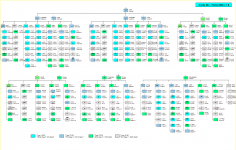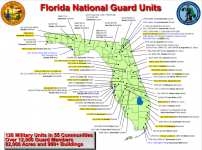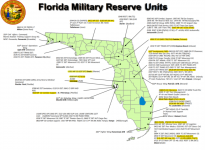GK .Dundas
Army.ca Veteran
- Reaction score
- 1,891
- Points
- 960
The occasional hill.Don't forget "very small rocks"

The occasional hill.Don't forget "very small rocks"
My thought is that it would be separate. eFP Latvia has a key role and is part of an allied infrastructure and therefore committed to a specific task.Couple of questions about your proposed 3 Mechanized Brigade in Latvia.
Would this replace our eFP Latvia commitment or would it be in addition to that? If 3 Brigade is in addition to eFP Latvia then presumably each force would require their own, separate equipment and support structures in theater.
Exactly. The 10% is primarily in the headquarters to allow all the requisite liaison and planning and the maintenance organizations to keep the equipment serviceable year-round. The maintenance teams would be spread throughout the brigade service battalion and battalion A Echs. We had something similar with Z Bty 1 RCHA. G Bty 3 RCHA was designated as the flyover battery. Z Bty itself had a Battery Captain (Bty 2i/c) and an entire maintenance and Bty QM there (roughly 15-20 people) as well as a full battery's worth of equipment. G Bty's BK (me at the time) and my maintenance and Bty QM det were designated as stay behind and would reform our M109 battery based on redistribution and augmentation on our existing equipment. (I snuck over as a FOO though)You show 3 Brigade as being 10/0 manning. I assume that means that the Canadian-based Brigades would only fly over for annual exercises rather than provide rotating limited manning of the Brigade? The Brigade HQ and the Maintenance Coy might possibly be at higher manning levels to coordinate with Allied units/service the pre-positioned equipment I'm thinking.
Not a complete HQ. The bulk of the brigade headquarters comes from the three Canadian based brigades. There would, however, be enough planning staff to allow year-round liaison with the next higher US headquarters (probably a divisional headquarters), participation in their CPXs/CAXs, planning and preparation for flyover components, coordination of year-round sustainment of equipment, maintenance of in theatre war stocksDo you see 3 Brigade as an actual separate Brigade HQ and unit structure or would on activation one of the three Canada-based Brigades just basically take over the equipment with the other two Brigades filling out the missing sub-units (until such time as the 10/90 sub-units can be worked up and rotated in)?
An AD regiment is contained in 36 Arty Bde. It's purpose is to provide AD for any deployed force that needs it including to 3 Bde, however, the need for AD in 3 Bde would be part and parcel to the overall AD structure in V Corps and what commitment Canada makes to that.And what about AD for your 1 Division/Latvia Brigade?
Each of my field regiments consist of three six-gun batteries, a UCAV battery and an STA troop. Guns are either M777s, C3s or G1s depending on the unit. UCAV equipment is as yet undefined. There is no AD allocated to any of the field regiments.You have equipment for a single Artillery Regiment in the pre-positioned Brigade. Does each Artillery Regiment have an AD Battery integrated (2 x 6 gun batteries and an AD Battery?). Or are you assuming that whatever Division we're under will provide AD?
There is an additional notional HIMARS regiment within 38 Arty Bde and in previous iterations I allotted one of its batteries to augment 3 Bde's artillery regiment. I will probably do so again if for nothing else for flyover training purposes because the regiment is primarily a ResF regiment. Obviously the deployment of any such battery is dependent on the Army actually having a project to field such a system.Your Artillery Brigade shows three Gun Regiments and a HIMARS Regiment. If we're realistically only looking at supporting a single Mechanized Brigade rather than deploying a full Division then maybe an AD Regiment would be more useful than a HIMARS Regiment?
One concern with your proposed force structure and keeping eFP Latvia separate is that you have a total of 6 x 100/0 LAV Companies in Canada presumably with these providing the eFP Company on a rotational basis. If something kicks off rapidly vs Russia that leaves you 1 x LAV company short for your flyover 3 Brigade force. This can eventually be made up as a Reserve Company is brought together, but still leaves your rapid deployment force less than fully manned.My thought is that it would be separate. eFP Latvia has a key role and is part of an allied infrastructure and therefore committed to a specific task.
My thought on 3 Bde would be as a separate force separate from eFP Latvia. Where it would actually be located is a question in my mind for the moment. I'm thinking more in Poland as part of the US V Corps because there are better training areas and facilities there, much of V Corps is flyover, it would let us tie into the US sustainment chain and earn us particular brownie points with the US.
Exactly. The 10% is primarily in the headquarters to allow all the requisite liaison and planning and the maintenance organizations to keep the equipment serviceable year-round. The maintenance teams would be spread throughout the brigade service battalion and battalion A Echs. We had something similar with Z Bty 1 RCHA. G Bty 3 RCHA was designated as the flyover battery. Z Bty itself had a Battery Captain (Bty 2i/c) and an entire maintenance and Bty QM there (roughly 15-20 people) as well as a full battery's worth of equipment. G Bty's BK (me at the time) and my maintenance and Bty QM det were designated as stay behind and would reform our M109 battery based on redistribution and augmentation on our existing equipment. (I snuck over as a FOO though)
My thought is that 3 Bde's role (besides its obvious war time role) is the peace time role of replacing CMTC as the primary formation training organization for the CAF (particulalry 1 Div) where the aggregated Reg F components would fly over at least once per year (let's say Apr or May - maybe also late Oct/November) for the culmination of their collective training phases and training year and the aggregated ResF components in maybe two serials in late July and early Aug for their annual concentrations.
Not a complete HQ. The bulk of the brigade headquarters comes from the three Canadian based brigades. There would, however, be enough planning staff to allow year-round liaison with the next higher US headquarters (probably a divisional headquarters), participation in their CPXs/CAXs, planning and preparation for flyover components, coordination of year-round sustainment of equipment, maintenance of in theatre war stocks
Effectively on mobilization one or the other (or a combination) of the Canadian based brigades would fill out probably 95% of 3 Bde's establishment adding on to half of the 3 Bde's personnel while the other half of 3 Bde's personnel would form part of the theatre's Canadian command and support elements. How the latter would function is obviously an issue as to the depth of the arrangement with V Corps. It might require additional flyover forces for theatre level Canadian sustainment and support elements (which would come from 1 Div's 31 Sustainment Brigade and 2 Div's 6 Combat Support Brigade.). I haven't gone too deeply into that because its too nebulous. I have provided mobilizable elements to form that structure, however.
I guess a lot depends on how you envision 3 Brigade being employed. If you're envisioning a Brigade that for political reasons you wish to have some operational autonomy it might serve a role similar to the later "mobile reserve" role of 4 CMBG. In that case you might want to push down more key enablers (AD, EW, Recce, etc.) down to the Brigade Group level.An AD regiment is contained in 36 Arty Bde. It's purpose is to provide AD for any deployed force that needs it including to 3 Bde, however, the need for AD in 3 Bde would be part and parcel to the overall AD structure in V Corps and what commitment Canada makes to that.
As far as the eFP force is concerned, AD resources there depend on the overall structure of the NATO Multinational Div North that the eFP Latvia belongs to.
As noted above I think that the correct structure for our Artillery forces is highly dependent on how we plan to employ our Mechanized forces and integrate them into our allied force structures.Each of my field regiments consist of three six-gun batteries, a UCAV battery and an STA troop. Guns are either M777s, C3s or G1s depending on the unit. UCAV equipment is as yet undefined. There is no AD allocated to any of the field regiments.
I've allocated the force two artillery brigades. 38 Arty bde in Shilo commands three field regiments organized as above, a General Support Regiment (notionally for HIMARS) and the divisional reconnaissance regiment (in a structure to work like the UK Deep Strike BCT) all focused on 1 CA Div's role. 36 Arty Bde in Quebec has 3 x Fd Regts and an Air Defence Regiment. The Fd regiments support 2 Div while the AD Regt is general support for both divs. Note the artillery structure with 36 Bde is a significant departure from previous iterations of my force structure.
As to 3 Bde's artillery regiment, I see it having 3 x M777 batteries, a UCAV battery, a recce squadron, and possibly a HIMARS battery and possibly an AD battery (depending on the arrangements with V Corps)
There is an additional notional HIMARS regiment within 38 Arty Bde and in previous iterations I allotted one of its batteries to augment 3 Bde's artillery regiment. I will probably do so again if for nothing else for flyover training purposes because the regiment is primarily a ResF regiment. Obviously the deployment of any such battery is dependent on the Army actually having a project to field such a system.
I've always included a plan for an "AD Regiment" in the structure based on the existing GBAD project. The size of that Regt will vary depending on the number of systems that will be procured under GBAD. My plan is for a three battery regiment in Canada with one RegF battery, fully equipped and two ResF batteries without equipment and training on the RegF equipment. Assuming that there is enough equipment purchased for a second battery then I would position it with 3 Bde to permit flyover training on it.
I think that both a HIMARS and an AD regiment are necessary for Canada. My question is where to place it? In earlier iterations I have placed HIMARS in a General Support Arty Bde together with a GS field regiment (guns only, no observers), and an AD Regt in order to provide general support as required by either brigade. More recently I have decided that it might be more efficient to target the HIMARS system to Europe and couple it with a Deep Strike Recce element (either brigade or Divisional capable). The Ukrainian model has influenced me greatly that Deep Strike is a viable concept that should be exploited by coupling recce and arty (rockets and UCAVs in particular but also guns with ever increasing ranges).
That left me pondering artillery support in 2 Div.
1 Div is built with the idea of prepositioning one brigade in Europe with existing equipment and being able to form a second brigade out of aggregating existing equipment in Canada that could be deployed into a two-brigade division in Europe in an extreme situation and where time to deploy is available.
2 Div on the other hand is designed specifically for deploying lighter battle groups on a variety of missions that might or might not be in NATO Europe. Their brigade HQs would be deploying more in the nature of an NCE than a fighting brigade HQ. I'd originally left the bulk of 2 Div's artillery as part of each brigade but have changed my mind and also created an arty brigade for 2 Div to aggregate their guns which means that this arty brigade is less of a general support bde but more of a close support one with administrative control over the AD Regiment which I see located in Gagetown and the Maritimes (but tasked for AD support for the Army as a whole). I've moved this arty brigade's HQ from Halifax to Quebec City to be more centrally located to the arty regiments that are its components - 2 RCHA, 5 RALC, 4 RCA(GS), 42 Fd, 30 Fd, 2 Fd, 6 Fd, 62 Fd, 1 Fd, 3 Fd, 84 Bty What will now be 37 Arty Bde will have four key operational bases: Petawawa (formed around 2 RCHA), Valcartier (formed around 2 Fd and 5 RALC), and Gagetown (formed around 4 RCA (GS) renamed back to 4 AD)

The whole idea behind 30/70 forces is to increase the ability of the ResF units to, in time, be capable of running LAVs so that they will routinely take on Latvia rotos and be on higher states of readiness than they are now.One concern with your proposed force structure and keeping eFP Latvia separate is that you have a total of 6 x 100/0 LAV Companies in Canada presumably with these providing the eFP Company on a rotational basis. If something kicks off rapidly vs Russia that leaves you 1 x LAV company short for your flyover 3 Brigade force. This can eventually be made up as a Reserve Company is brought together, but still leaves your rapid deployment force less than fully manned.
For me the issue isn't necessarily how I see it employed but more as one of providing capabilities that will give the government options when they have an issue that needs addressing.I guess a lot depends on how you envision 3 Brigade being employed. If you're envisioning a Brigade that for political reasons you wish to have some operational autonomy it might serve a role similar to the later "mobile reserve" role of 4 CMBG. In that case you might want to push down more key enablers (AD, EW, Recce, etc.) down to the Brigade Group level.
It could also expand the existing eFP commitment in Latvia to that of a Canadian-led multi-national Brigade in place of the existing multi-National Battle Group. Currently the Division is organized as the Estonian 1st Infantry Brigade with eFP Estonia attached and the Latvian Mechanized Infantry Brigade with eFP Latvia attached. Canada could provide the basis of a 3rd Maneuver Brigade for the Division.
In that case you may only need one fly-over Mech Battalion and the Tank Regiment in addition to the Mech Company in the multi-national Battalion. You could also look at organizing our units as Combined Arms Battalions rather than a separate Tank Regiment and LAV Battalion to more closely match the way the eFP Battle Group is currently configured. As you say above, the AD and other enablers in this case would depend on how NATO Multi-national Division North is supporting elements are structured.
If instead 3 Brigade is to be embedded as one of the maneuver elements of an American Division then presumably we don't require our own integrated enablers like AD (or even Artillery) if we're going to follow their general BCT organizational structure. This might be a bit of a tougher sell politically as our forces would be seen as working directly under US command in a way that would not be so obvious if we were an "independent" Brigade or part of a multi-national Division (which would both in reality still be operating under overall US command of course!).
This last option would actually be the easiest for us to fulfill in the long term if we were to move to US vehicles and equipment as our existing gear needs to be replaced so that we could fully integrate into the US support structures.
As noted above I think that the correct structure for our Artillery forces is highly dependent on how we plan to employ our Mechanized forces and integrate them into our allied force structures.



Understood, but there are agencies, like intelligence, CIMIC and the MPs now who are spread out like that. The US Army Reserve and Army National Guard also function with widely distributed sub units such as engineering companies, special force companies etc.I don’t think you will find success in a model that sees field units having their sub-units spread from Victoria to Halifax.
Finally note that I've assigned names to the various battalions and companies more as gut level staff check on the ability to round out the establishments with existing RegF and ResF strengths and geographic ability to function together.
Understood, but there are agencies, like intelligence, CIMIC and the MPs now who are spread out like that. The US Army Reserve and Army National Guard also function with widely distributed sub units such as engineering companies, special force companies etc.
Intercommunication systems make these types of structures more possible than ever.
I think that one of the ResF greatest contributions to the country is its reach into the local communities which the RegF has completely abandoned by virtue of their concentration into a small handful of super (by our standards) bases.
Wherever possible the units and their subunits have been grouped geographically but there are some situations where it can't be helped. Artillery on the Pacific coasts is a perfect example. There are two regiments but their numbers are basically a battery and a troop. There are two main solutions - have them under command of the coastal regiment/ brigade which takes them out of the artillery chain and leaves them no further ahead than now or assign them to an artillery organization that shares and controls their mission set. That in fact is the purpose behind 1 Fd Regt - to manage and control two units that provide support to two light infantry coastal regiments. One could also have them part of the 1 (CA) Div but "over the mountains" relationships are just as tenuous as across the country ones.
I think that you'll find, when you try to parse the best possible solution, that there just isn't always an optimum one available.

Seems like a possible easy fix by focusing on having sub units for CS and CSS units drawn from their end of the country even if you cant do most armored engineer roles in Vancouver for example.I don’t think you will find success in a model that sees field units having their sub-units spread from Victoria to Halifax.
This is completely unacceptable and unworkable as the Royal Westminster Regiment won't be given the jump tasking and as you may know the regiment was a jump regiment not so long ago....../sWell I said I was going to inflict another Napkin Force on everyone so here it is:
View attachment 74707
Funny that you should mention that as I thought there was another jump status ResF unit other than the QOR and was surprised to learn QOR was the only one these days. I'm perhaps overdoing the jump capability as I did add another one with the Voltigers to give 5 Bde a little depth and besides I think its a great draw to bring in keen young ResF soldiers if there's an opportunity for them.This is completely unacceptable and unworkable as the Royal Westminster Regiment won't be given the jump tasking and as you may know the regiment was a jump regiment not so long ago....../s
That's exactly right.All jokes aside I myself was thinking much the same thing with an attempt at a heavy and light division on each side of the country as we have a lot of manpower tied up in the 5 division construct atm. I would probably suggest trying to keep subunits on one side of the country. But as I have said before so much of the location and size of units is going to be dictated by the infrastructure which this does a good job of keeping to.


Not arguing the fact that there are ways to overcome the geography issues but just noting that Florida is 16% the size of Manitoba but has a population that's almost 60% of the total population of Canada.The fact is that working with existing infrastructure and unit type distribution across the country makes it difficult to keep things grouped as tightly as one wants. It's not a big problem as long as you have independent 140 man battalions grouped under an administrative headquarters but the moment you convert those to a 140 man companies that report to an operational battalion headquarters then the exercise becomes difficult except in the biggest urban centres. As I mentioned above, that shouldn't be the big issue most of us here in Canada think as the Guard in the US exists mostly in company sized armouries spread all around urban and rural areas.
Here's a quick view of Florida NG and USAR units the vast majority of which are company or detachment sized entities.
You can see how widely they are distributed throughout the state in company sized armories. About half of these units belong to Florida's 53 IBCT out of Tampa but just as many belong to higher units and formations outside the state such as A Co of the 3 Bn of the 20th Special Forces Group in Ocala. The Bn is headquartered at Ft Blanding has another company in North Carolina and reports to its group headquarters in Birmingham Alabama.
That's not a fair comparison. Florida is occupied from one end to the other except for that little swamp in the south while 90% of Manitoba's population lives in a strip of land some 200 kms long and maybe 50 wide. The "populous" area of Florida exceeds that of Manitoba's several fold.Not arguing the fact that there are ways to overcome the geography issues but just noting that Florida is 16% the size of Manitoba but has a population that's almost 60% of the total population of Canada.
It's not geography that defeats us; its lack of imagination.
34th Infantry Division (United States) - Wikipedia
en.wikipedia.org
The US currently has some 1,350,000 active and 800,000 reserve military personnel for a population of 332 million. Canada purportedly 68,000 regular and 27,000 reserves (which must include Rangers and a lot of NES). Essentially we have 11% of the US population and 4.4% of their military establishment (on a good day). It's no wonder they have a higher previous service rate.The US also has a much higher rate of military participation than Canada. Approx. 7% of Americans have prior military service while only 1.5% of Canadians are veterans. I'm assuming that translates into a much higher percentage of USNG/AR members having previously been in Active Service (and therefore have a higher baseline level of training and experience) than Canadian Reservists.
Despite everything we had a lot of reservists in Afghanistan too. While they gained a lot of experience, many of them didn't bring it back to the units. Reserve COs that I've talked to said they would come back and be bored out of their gourds and many went to join the RegF or took other Class B contracts or left.
Very sad as those Reservists with significant overseas operational experience could have been an excellent foundation on which to build a new culture in the Reserves.My observation was that alot of them left because they were treated like shit, despite anything that people like me could do to correct those problems.
You can, if you look at the US ARNG prior to 9/11 it had a lot of problems. It had even more problems pre GW1.Very sad as those Reservists with significant overseas operational experience could have been an excellent foundation on which to build a new culture in the Reserves.
This kind of goes to my point above that we can't just take a model from another country (National Guard, Nordic country conscripts or Ukrainian "volunteers") and try to replicate them in Canada. Our culture, geography, facilities, capabilities and political realities are different.
Again, doesn't mean that our unique problems can't be resolved, just that we need to adapt any model to our own realities for it to work.
Depends. I have a group shot of seven of my troops on deployment, over a decade ago (with names & ranks on the back, plus the names and ranks of three more at deployed at the same time).My observation was that alot of them left because they were treated like shit, despite anything that people like me could do to correct those problems.
Funny that you should mention that as I thought there was another jump status ResF unit other than the QOR and was surprised to learn QOR was the only one these days. I'm perhaps overdoing the jump capability as I did add another one with the Voltigers to give 5 Bde a little depth and besides I think its a great draw to bring in keen young ResF soldiers if there's an opportunity for them.
That's exactly right.
The fact is that working with existing infrastructure and unit type distribution across the country makes it difficult to keep things grouped as tightly as one wants. It's not a big problem as long as you have independent 140 man battalions grouped under an administrative headquarters but the moment you convert those to a 140 man companies that report to an operational battalion headquarters then the exercise becomes difficult except in the biggest urban centres. As I mentioned above, that shouldn't be the big issue most of us here in Canada think as the Guard in the US exists mostly in company sized armouries spread all around urban and rural areas.
Here's a quick view of Florida NG and USAR units the vast majority of which are company or detachment sized entities.
View attachment 74717
View attachment 74716
You can see how widely they are distributed throughout the state in company sized armories. About half of these units belong to Florida's 53 IBCT out of Tampa but just as many belong to higher units and formations outside the state such as A Co of the 3 Bn of the 20th Special Forces Group in Ocala. The Bn is headquartered at Ft Blanding has another company in North Carolina and reports to its group headquarters in Birmingham Alabama.
If you discount BC, there's a pretty good dividing line for the Army based on the Ottawa valley and the Quebec Ont border north of that. The Reg F has a brigade on either side of that and one right on the border. Similarly numbers of ResF units balance out very roughly as between the east and the west with (based on some old figures) with roughly 2,400 on the Prairies, 5,200 in Ont, 4,200 in Que and 3,000 in the Maritimes. The question then is what do you do with BC's 1,500? It's very hard to put them into a mechanized force but they are quite well suited for light infantry and associated roles.
If you accept that the the west is the best place for mech training (Wainwrights and Shilo) then you are stuck with the fact that a 30/70 structure requires 1/3rd of 1 CMBG and all of the ResF in the Prairies to make one bde which pushes the other two bdes and their sustainment infrastructure into the population centres of Ont. Concurrently the weigh the light force towards a 70/30 or so establishment you need to add 2 Bde to the eastern divide (make the boundary Hwy 17 rather than the river) and you end up assigning much of 33 Bde to be the ResF roundout to 2 Bde. On top of that 33 Bde is the weakest of Ontario's three brigades and wouldn't be able to form the core of a good mech bde which slides you over to Montreal for the 3rd mech bde. It is well suited for it.
BC will always be a problem for RegF/ResF organizational structures. It's less of a problem where the demands on the ResF units isn't high and ResF leadership is left to their own devices on the other side of the mountains. BC will always be an outlier regardless of what criteria you use for the organization. A simple geographic grouping with the "Army of the West" might be seductive but is impractical once you add a functional break with a Europe-focused division. I prefer 39 Bde to have a coastal focus which functionally puts it into the "Light" Division.
Functional command trumps geographic in my books.


